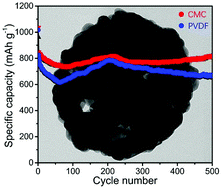Enhanced reversible capability of a macroporous ZnMn2O4/C microsphere anode with a water-soluble binder for long-life and high-rate lithium-ion storage†
Abstract
Among the many transition metal oxides, ZnMn2O4 provides relatively high theoretical capacity, low cost, low toxicity, and environmental friendliness for high-performance lithium-ion batteries. However, ZnMn2O4 suffers from limited cycle life, originating from poor electronic conductivity and huge volume change. In this work, ZnMn2O4/C consisting of many carbon layer-coated tiny nanoparticles, forming rough and macroporous microspheres, and microsphere anodes, with water-soluble sodium carboxymethyl cellulose or non-water-soluble poly(vinylidene fluoride), are characterized by electrochemical testing. As a result, the cell with water-soluble sodium carboxymethyl cellulose was shown to exhibit a high reversible capacity of 1249 mA h g−1 after 100 cycles at a low current density of 200 mA g−1. Even at a high current density of 500 mA g−1, it still retains a reversible capacity of 820 mA h g−1 after 500 cycles with a high coulombic efficiency, thus indicating its long life and high rate.



 Please wait while we load your content...
Please wait while we load your content...